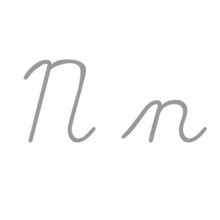N
|

N (named en /ˈɛn/[1]) is the 14th letter in the modern English alphabet and the ISO basic Latin alphabet.
History
| Egyptian hieroglyph for J |
Phoenician Nun |
Etruscan N |
Greek Nu | ||
|---|---|---|---|---|---|
|
|
|
|
One of the most common hieroglyphs, snake, was used in Egyptian writing to stand for a sound like the English ⟨J⟩, because the Egyptian word for "snake" was djet. It is speculated by many that Semitic people working in Egypt adapted hieroglyphics to create the first alphabet, and that they used the same snake symbol to represent N, because their word for "snake" may have begun with that sound. However, the name for the letter in the Phoenician, Hebrew, Aramaic and Arabic alphabets is nun, which means "fish" in some of these languages. The sound value of the letter was /n/—as in Greek, Etruscan, Latin and modern languages.
Use in writing systems
⟨n⟩ represents a dental or alveolar nasal in virtually all languages that use the Latin alphabet, and in the International Phonetic Alphabet. A common digraph with ⟨n⟩ is ⟨ng⟩, which represents a velar nasal in a variety of languages, usually positioned word-finally in English. Often, before a velar plosive (as in ink or jungle), ⟨n⟩ alone represents a velar nasal. In Italian and French, ⟨gn⟩ represents a palatal nasal /ɲ/. The Portuguese and Vietnamese spelling for this sound is ⟨nh⟩, while Spanish and a few other languages use the letter ⟨ñ⟩. In English, ⟨n⟩ is generally silent when it is preceded by an ⟨m⟩ at the end of words, as in hymn; however, it is pronounced in this combination when occurring word medially, as in hymnal.
⟨n⟩ is the sixth most common letter and the second-most commonly used consonant in the English language (after ⟨t⟩).[2]
Other uses
In mathematics, the italic form n is the common symbol for a variable quantity, especially one which represents an integer. is often used to refer to the set of natural numbers.
In statistics, the italic form n is used to denote the number of observations or replicates included in a statistical sample.
In chemistry, N represents the element nitrogen. In biochemistry, N is the one-letter code symbol for the amino acid asparagine. It is also the symbol for the SI unit of force, the newton.
Related characters
Descendants and related characters in the Latin alphabet
- N with diacritics: Ń ń Ñ ñ Ň ň Ǹ ǹ Ṅ ṅ Ṇ ṇ Ņ ņ
- Phonetic alphabet symbols related to N (the International Phonetic Alphabet only uses lowercase, but uppercase forms are used in some other writing systems):
- Ŋ ŋ : Latin letter eng, which represents a velar nasal in the IPA
- Ɲ ɲ : Latin letter Ɲ, which represents a palatal nasal or an alveolo-palatal nasal in the IPA
- Ƞ ƞ : Latin letter Ƞ (encoded in Unicode as "N with long right leg"), a mostly obsolete letter used to transcribe various nasal sounds
- ɳ : Latin letter n with a hook, which represents a retroflex nasal in the IPA
- ɴ : Small capital N, which represents a uvular nasal in the IPA
Ancestors and siblings in other alphabets
- 𐤍 : Semitic letter Nun, from which the following symbols originally derive
- Ν ν : Greek letter Nu, from which the following symbols originally derive
- Ⲛ ⲛ : Coptic letter Ne
- Н н : Cyrillic letter En
- 𐌍 : Old Italic N, which is the ancestor of modern Latin N
- 𐌽 : Gothic letter nauþs
- Ν ν : Greek letter Nu, from which the following symbols originally derive
Derived signs, symbols and abbreviations
- ₦ : Nigerian Naira
Computing codes
| Character | N | n | ||
|---|---|---|---|---|
| Unicode name | LATIN CAPITAL LETTER N | LATIN SMALL LETTER N | ||
| Encodings | decimal | hex | decimal | hex |
| Unicode | 78 | U+004E | 110 | U+006E |
| UTF-8 | 78 | 4E | 110 | 6E |
| Numeric character reference | N | N | n | n |
| EBCDIC family | 213 | D5 | 149 | 95 |
| ASCII 1 | 78 | 4E | 110 | 6E |
- 1 Also for encodings based on ASCII, including the DOS, Windows, ISO-8859 and Macintosh families of encodings.
Other representations
References
- ↑ "N" Oxford English Dictionary, 2nd edition (1989); Merriam-Webster's Third New International Dictionary of the English Language, Unabridged (1993); "en," op. cit.
- ↑ English Letter Frequency
External links
 The dictionary definition of n at Wiktionary
The dictionary definition of n at Wiktionary


